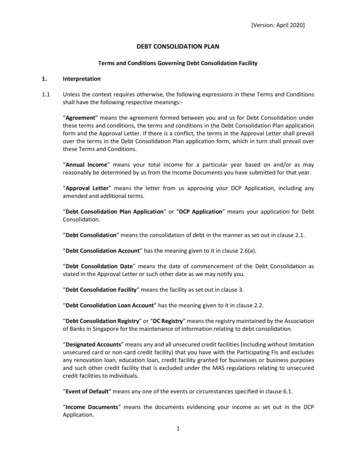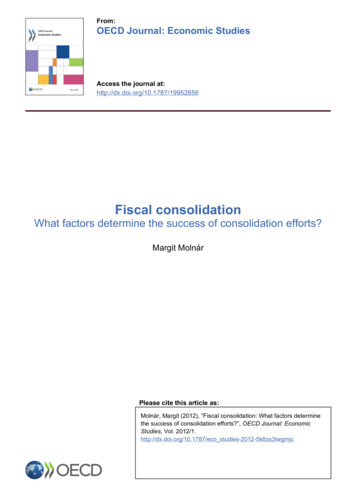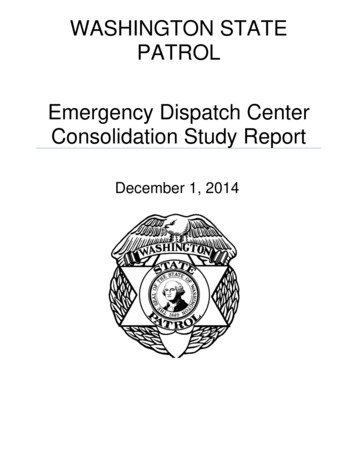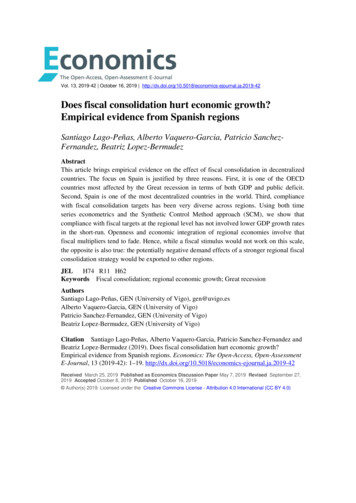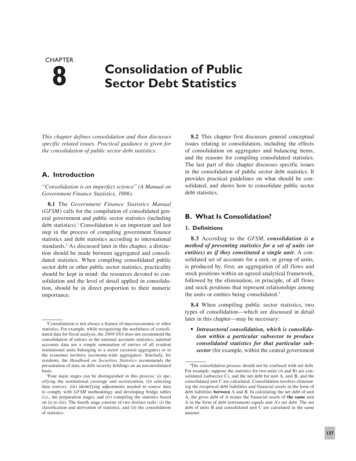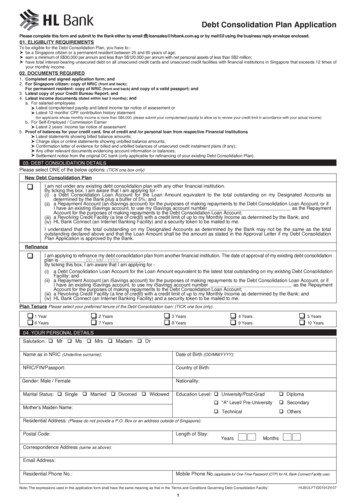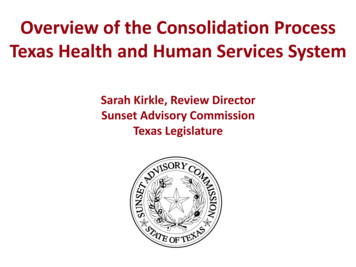
Transcription
Overview of the Consolidation ProcessTexas Health and Human Services SystemSarah Kirkle, Review DirectorSunset Advisory CommissionTexas Legislature
Agenda Background on Health & Human Services (HHS) in Texas Overview of HHS Consolidation and Reorganization Consolidation History Why Consolidate? Consolidation Overview Transition Plan Transition Legislative Oversight Committee Timeline for Consolidation Ongoing Oversight Questions?2
Health and Human Services in Texas Overall, Texas’ HHS system employs more than 54,000people and operates on a budget of 40 billion per year. Texas’ HHS consolidation was the result of Sunsetreviews of the HHS system. In Texas, each agency has a “sunset” date in law on which theagency automatically expires. The Sunset Commission reviewsand makes recommendations to the Legislature on whether tocontinue and how to improve agencies just before the agencyexpires. Sunset reviews are comprehensive agency evaluations thattypically take place every 12 years.3
Health and Human ServicesConsolidation Legislation to reorganize and consolidate five HHS agencies tothree passed in May 2015. Texas had five HHS agencies: Health and Human Services Commission (HHSC)Department of State Health Services (DSHS)Department of Aging and Disability Services (DADS)Department of Assistive and Rehabilitative Services (DARS)Department of Family and Protective Services (DFPS) After consolidation is completed on 9/1/17, Texas will havethree reorganized HHS agencies: Health and Human Services Commission (HHSC) Department of State Health Services (DSHS) Department of Family and Protective Services (DFPS)4
Pre-Consolidation HHS Structure5
History: 2003 HHS Consolidation Texas consolidated 12 HHS agencies to five Established a clear system of agencies, headed byan executive commissioner Required consolidation of administrative services(IT, budget, legal, etc.) across all five agencies Administrative consolidation was a key tenet of thisconsolidation and never fully accomplished Consolidation in 2003 was primarily driven by alarge state budget shortfall6
History: Lessons Learned from 2003 One-year timeframe was too short for a movethis size After “moving the boxes” so quickly, HHS staff ranout of steam and never finished the job ofintegrating the services for clients Need for continuous legislative oversight Focus must be on the clients. Criticism thatconsolidation purely for budget savings reducedservices to clients (consolidation bill also includeddrastic cuts to services to shore up the budget)7
HHS Consolidation 2015Why? Blurred accountability Five agencies, not one system Agencies act in silos or play tug-of-war Fragmented programs and functions Incomplete administrative consolidation Missed opportunities for budget savings and data-sharing Poorly integrated or overlapping client services (e.g., Medicaid inthree agencies, behavioral health services in all five) Results in duplicative or unnecessary services Integrated care improves outcomes and saves money Difficult for clients to navigate complex system8
HHS Consolidation 2015Why? Specific problems with the current structure Scattered regulatory services, poor focus on institutions Similar issues of aging infrastructure and workforce shortages Overly broad focus of Dept. State Health Services Jack of all trades, master of none; no focus on core mission Questionable future for Dept. Aging & Disability Services Transition to Medicaid managed care leaves little at this agency Small, singular focus of Dept. of Assistive & Rehabilitative Services Why is this its own agency? Competing priorities for Health & Human Services Commission tooversee the system while running Medicaid9
Overview of HHS ConsolidationAims to improve services to clients and make the state’s already bigand complex system work better through a measured approach toconsolidation that promotes accountability, reduces fragmentation,and streamlines operations across the system. Consolidates the functions of DARS and DADS at HHSC in aphased, two-year approach to be completed by 2017. MaintainsDSHS and DFPS as separate agencies but transfers certainfunctions from each to keep them focused on their primarypublic health and protective services missions. Transfers vocational rehabilitation programs to the WorkforceCommission in 2016 to better align those programs with theworkforce system and improve employment outcomes forpeople with disabilities.10
Example of Consolidated Organizational Structure11
Timeline of HHS ConsolidationMarch 1, 2016: Transition plan due from the executive commissioner to theTransition Legislative Oversight Committee.September 1, 2016 (Phase I): Consolidation of client services (Medicaid, behavioral health, women’shealth, aging services, disability services, etc.) Vocational rehabilitation services transfer to Workforce Commission Consolidation of prevention programs at Dept. of Family and ProtectiveServices Partial consolidation of system administrative servicesSeptember 1, 2017 (Phase II): Consolidation of institutions (IDD and behavioral health) and regulatoryfunctions Consolidation of remaining administrative functions feasible and desirableto be consolidated12
Administrative Consolidation The hardest consolidation to accomplish. Administrative services are the most difficult for independentagencies to give up because they feel that control over their ownIT or purchasing needs, for example, are fundamental to successof each program. These consolidations should occur on a different schedule thanbigger functional consolidations to avoid administrative servicestransitioning at the same time. Stable administrative servicescan help prevent interruptions in client services duringfunctional consolidations. Consolidation may not be desirable for all administrativefunctions (government relations, general counsel, chief financialofficer). Biggest potential for savings.13
Transition Plan Prepared by the HHSC executive commissioner Contents: An outline of the proposed HHS structure Timelines for transfers of functions Define specific programs included in each category of functionalrealignment (client services, regulatory, public health, etc) Evaluation and determination of the feasibility of administrativeconsolidation Requirements for public hearings throughout the statewhile developing the plan Plan due to the Transition Legislative OversightCommittee by March 1 (five months after the bill’seffective date)14
Ongoing Oversight: TransitionLegislative Oversight Committee (TLOC) Charge. To oversee the consolidation of health and humanservices in Texas. TLOC makes recommendations on thetransition and consolidation of services and provides anavenue for stakeholder and public input on the consolidation. Composition. Joint committee with 11 voting members, cochaired by a Senate and House member 4 members of the Senate, appointed by the lieutenantgovernor 4 members of the House, appointed by the speaker 3 members of the public, appointed by the governorThe executive commissioner of HHSC serves as an ex officiononvoting member.15
Ongoing Oversight: TransitionLegislative Oversight Committee (TLOC) Meetings. The committee must meet: at least quarterly from the time of its creation toSeptember 1, 2017; at least semi-annually from 2017 to 2019; and at least annually until its abolishment in 2023.(Note: In 2023, the agencies have a special sunset review.) Reporting. TLOC must report to the governor,lieutenant governor, speaker, and Legislature byDecember 1 of each even-numbered year on progressand other issues related to the reorganization.16
Ongoing Oversight: TransitionLegislative Oversight Committee (TLOC)Transition Plan Review TLOC is required to comment on and makerecommendations to the executive commissioneron the plan. The executive commissioner must consider thecomments and publish the transition plan withany changes recommended by TLOC. If the executive commissioner does notincorporate recommended changes, thecommissioner must include justification for whynot.17
Ongoing Oversight: Special ReviewsConsolidation legislation was effective 9/1/15Beyond TLOC oversight, several special reviews are plannedto provide ongoing oversight until next sunset review. Fall 2016: Sunset Compliance – Sunset staff reports agencyimplementation progress to the Sunset Commission. December 1, 2018: Recommendations from TransitionLegislative Oversight Committee to the Legislature whetherDFPS and DSHS should continue independently or bemerged into HHSC September 1, 2023: Special-purpose Sunset review of HHSCto evaluate progress of the reorganization, but HHSC is notsubject to abolishment. Standard Sunset review for DFPSand DSHS, subject to abolishment. September 1, 2027: Consolidated HHSC full Sunset review,subject to abolishment.18
Questions?19
Contact SunsetSarah Kirkle, Review DirectorSunset Advisory CommissionEmail: sarah.kirkle@sunset.texas.govPhone: (512) 463-1300Web: www.sunset.texas.gov20
Overly broad focus of Dept. State Health Services Jack of all trades, master of none; no focus on core mission Questionable future for Dept. Aging & Disability Services Transition to Medicaid managed care leaves little at this agency Small, singular focus of Dept. of Assistive & Rehabilitative Services



